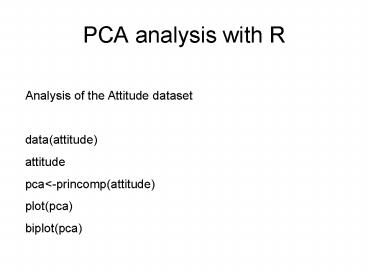PCA analysis with R - PowerPoint PPT Presentation
1 / 11
Title:
PCA analysis with R
Description:
Hastie et al. Genome Biology 2000 1(2) http://genomebiology.com/2000/1/2/research/0003 ... Regarding the samples as data points, do a PCA analysis to the dataset. ... – PowerPoint PPT presentation
Number of Views:65
Avg rating:3.0/5.0
Title: PCA analysis with R
1
PCA analysis with R
Analysis of the Attitude dataset data(attitude) a
ttitude pcalt-princomp(attitude) plot(pca) biplot(p
ca)
2
Homework
- (Due Sept 27) Read 'Gene shaving' as a method
for identifying distinct sets of genes with
similar expression patterns. Hastie et al. Genome
Biology 2000 1(2)http//genomebiology.com/2000/1/
2/research/0003/ - (Team, due Oct 4) Construct a dataset from the
colon cancer dataset with 5 genes and all
samples. These 5 genes should satisfy the
following criteria 1) with signals larger than
log2(100) in all the samples, 2) with the largest
variation across samples. Regarding the samples
as data points, do a PCA analysis to the dataset.
Plot the transformed samples in the space of the
first two principle components. Comment on your
results.
3
PCA, Case study
'Gene shaving' as a method for identifying
distinct sets of genes with similar expression
patterns. Hastie et al. Genome Biology 2000 1(2)
4
(No Transcript)
5
(No Transcript)
6
1 gene remains
7
(No Transcript)
8
(No Transcript)
9
(No Transcript)
10
(No Transcript)
11
Issues in dimension reduction
- Feature selection what genes (features) are used
to construct the original high-dimensional space
containing the samples points? - Genes with large variation across samples so
sample points are farther apart from each other - Genes related by biological aspects (e.g. the
same cell-cycle phase or function group). Then
samples will separate in a way to reflect their
relevance to these biological aspects - Start from all genes and iteratively keep genes
that contribute more to the first few principle
components































